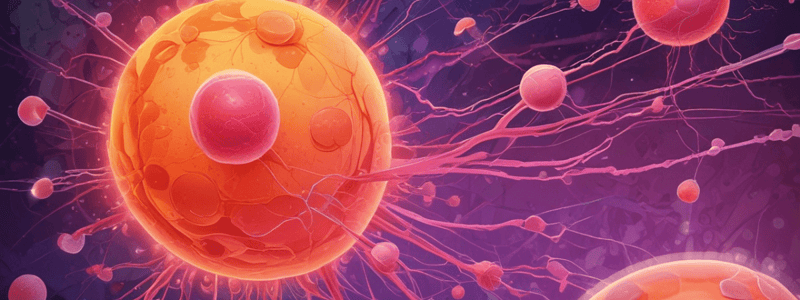Podcast
Questions and Answers
What is the chromosomal translocation that characterizes Acute Promyelocytic Leukemia (APL)?
What is the chromosomal translocation that characterizes Acute Promyelocytic Leukemia (APL)?
t(15;17)
What is the function of the PML-RARA fusion protein in APL?
What is the function of the PML-RARA fusion protein in APL?
It disrupts normal hematopoiesis and inhibits the differentiation of promyelocytes, causing them to accumulate in the bone marrow.
What is the frequency of the t(15;17) translocation in APL cases?
What is the frequency of the t(15;17) translocation in APL cases?
>95%
What is the overall survival rate of APL patients with modern treatment protocols?
What is the overall survival rate of APL patients with modern treatment protocols?
What is the effect of age on the prognosis of APL patients?
What is the effect of age on the prognosis of APL patients?
What is the mechanism of action of all-trans retinoic acid (ATRA) in APL treatment?
What is the mechanism of action of all-trans retinoic acid (ATRA) in APL treatment?
What is the role of arsenic trioxide in APL treatment?
What is the role of arsenic trioxide in APL treatment?
What is a common symptom of bleeding complications in APL patients?
What is a common symptom of bleeding complications in APL patients?
What is a common laboratory finding in APL patients?
What is a common laboratory finding in APL patients?
What is the potential long-term consequence of APL if left untreated?
What is the potential long-term consequence of APL if left untreated?
Study Notes
Pathogenesis
- Acute Promyelocytic Leukemia (APL) is a subtype of Acute Myeloid Leukemia (AML)
- Characterized by a chromosomal translocation, t(15;17), which leads to the fusion of the PML gene on chromosome 15 with the RARA gene on chromosome 17
- This fusion protein (PML-RARA) disrupts normal hematopoiesis, leading to the proliferation of immature myeloid cells
- PML-RARA also inhibits the differentiation of promyelocytes, causing them to accumulate in the bone marrow
Cytogenetics
- The t(15;17) translocation is present in >95% of APL cases
- The PML-RARA fusion protein is detectable in nearly all APL cases
- Other chromosomal abnormalities, such as trisomy 8, may be present in up to 20% of cases
- Cytogenetic analysis is essential for diagnosis and monitoring of APL
Prognosis
- APL has a high cure rate, with overall survival rates of 80-90% in modern treatment protocols
- Early diagnosis and treatment are crucial, as APL can progress rapidly and lead to bleeding complications
- Factors that affect prognosis include:
- Age: older patients have a poorer prognosis
- WBC count: higher counts are associated with a poorer prognosis
- Presence of secondary chromosomal abnormalities: may indicate a poorer prognosis
Treatment Options
- All-trans retinoic acid (ATRA) is a key component of APL treatment, as it induces differentiation of promyelocytes
- ATRA is often combined with chemotherapy, such as anthracyclines and cytarabine
- Arsenic trioxide is also used in the treatment of APL, particularly in patients who are resistant to ATRA
- Stem cell transplantation may be considered in some cases, particularly in those with high-risk disease
Clinical Presentation
- APL often presents with symptoms related to bleeding complications, such as:
- Easy bruising
- Petechiae
- Ecchymoses
- Hemorrhage
- Other common symptoms include:
- Fatigue
- Weight loss
- Fever
- Bone pain
- Laboratory findings typically include:
- Anemia
- Thrombocytopenia
- Leukocytosis with abnormal promyelocytes
- Coagulopathy, including disseminated intravascular coagulation (DIC)
Pathogenesis
- Acute Promyelocytic Leukemia (APL) is a subtype of Acute Myeloid Leukemia (AML) characterized by a chromosomal translocation, t(15;17)
- t(15;17) translocation leads to the fusion of the PML gene on chromosome 15 with the RARA gene on chromosome 17, forming a PML-RARA fusion protein
- PML-RARA fusion protein disrupts normal hematopoiesis, causing proliferation of immature myeloid cells and accumulation of promyelocytes in the bone marrow
Cytogenetics
- t(15;17) translocation is present in >95% of APL cases
- PML-RARA fusion protein is detectable in nearly all APL cases
- Other chromosomal abnormalities, such as trisomy 8, may be present in up to 20% of cases
- Cytogenetic analysis is essential for diagnosis and monitoring of APL
Prognosis
- APL has a high cure rate, with overall survival rates of 80-90% in modern treatment protocols
- Early diagnosis and treatment are crucial to prevent bleeding complications
- Prognosis is affected by age, with older patients having a poorer prognosis
- WBC count and presence of secondary chromosomal abnormalities also impact prognosis
Treatment Options
- All-trans retinoic acid (ATRA) induces differentiation of promyelocytes and is a key component of APL treatment
- ATRA is often combined with chemotherapy, such as anthracyclines and cytarabine
- Arsenic trioxide is used in APL treatment, particularly in patients resistant to ATRA
- Stem cell transplantation may be considered in high-risk disease cases
Clinical Presentation
- APL often presents with symptoms related to bleeding complications, such as easy bruising, petechiae, ecchymoses, and hemorrhage
- Fatigue, weight loss, fever, and bone pain are common symptoms
- Laboratory findings typically include anemia, thrombocytopenia, leukocytosis with abnormal promyelocytes, and coagulopathy, including disseminated intravascular coagulation (DIC)
Studying That Suits You
Use AI to generate personalized quizzes and flashcards to suit your learning preferences.
Description
Learn about the pathogenesis of Acute Promyelocytic Leukemia, a subtype of Acute Myeloid Leukemia, including its chromosomal translocation and effects on hematopoiesis. Discover how the PML-RARA fusion protein disrupts normal cellular processes.




